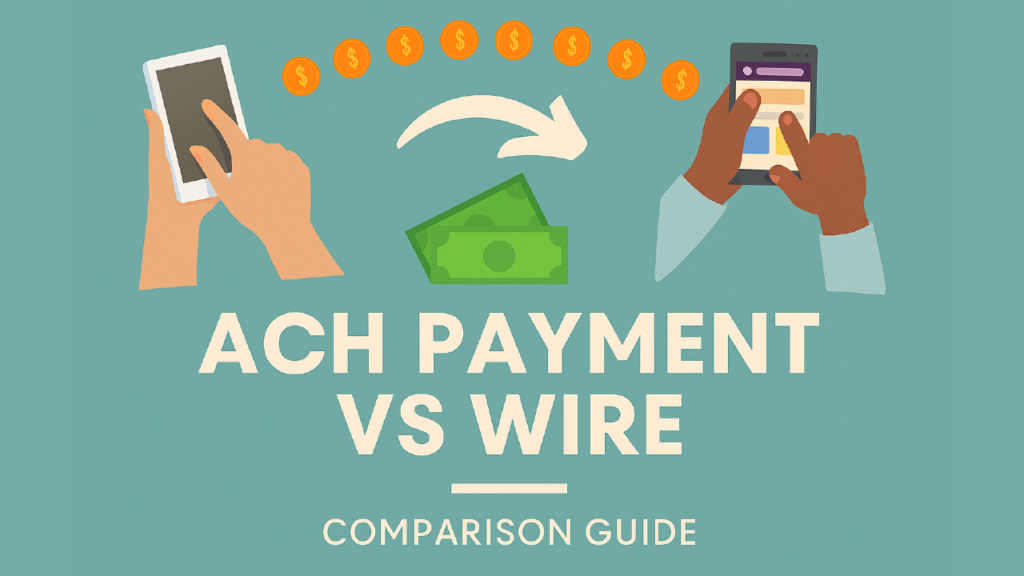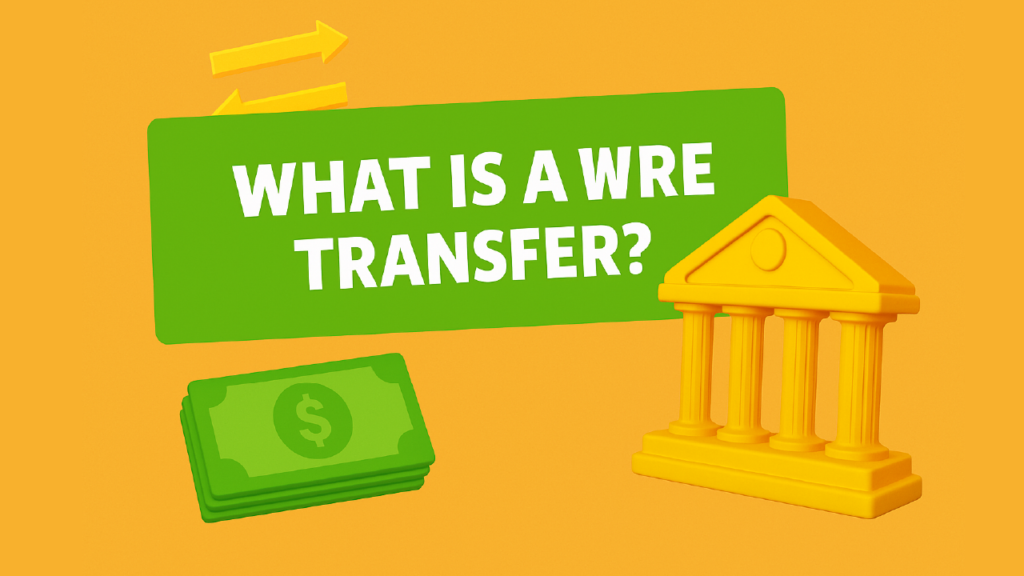
Introduction
The knowledge of distinguishing ACH payment vs wire is critical when making choices of how to send or receive money electronically.
These two forms are the most popular means of electronic funds transfers, and both have their strong and weak sides. In most cases, ACH transfers are cheaper yet slower compared to wires, which are rather quicker and more expensive.
Compare ACH payment vs wire to choose the best option for your transaction needs, like cost, speed, or security.
Here, we will explore ACH payment vs wire in detail, including similarities and differences, as well as some of their application area, or when and not to use them, and their considerations when afinishing to choose one of them.
What is an ACH payment?
Automated Clearing House payments, which is also referred to as ACH, are an electronic transfer of funds between various banks, and this happens via the Automated Clearing House network.
This system is operated by the National Automated Clearing House Association (NACHA) and has more than 10000 financial institutions (banks and credit unions), which form part of it.
It is the reason why ACH payments are utilized by the majority of customers to conduct small payments that are not urgent in terms of transfer.
Payment methods for ACH payments?
There is a variety of transactions that can be done through ACH, which include paycheck deposits, paying bills, and even international payments.
To move money, ACH is the method that peer-to-peer (P2P) payment apps such as Venmo and PayPal employ.
Because of its simplicity and minimal or even zero cost. ACH has subsequently become one of the most used payment systems. With more than 8.2 billion transactions realized within the first quarter of 2024 alone.
Although the ACH payments may seem simple, they are a complicated undertaking with multiple parties.
The method of ACH payment
Through ACH payment, the process of sending funds between the Originator (the person sending money) and the Receiver (the person receiving money) is feasible. There are three nuts and bolts of these transfers:
- Originating Depository Financial Institution (ODFI)
- Receiving Depository Financial Institutions (RDFI)
ACH Operator
An ACH transfer may be sent out in two ways. Or the Originator asks to transfer funds out of his/her account to one of the Receivers, as with the P2P payments.
Or the Receiver could request that some amount be paid by the Originator into his bank account. Like in the pre-approved recurring payments of bills.
The ACH payment is similar in both cases. A processing partner is the facility given the power to approve a transaction by the Originator.
The ODI receives files on individual transactions and forwards the files to the ACH operator in the form of batches several times a day.
The transactions are processed by the ACH, and the files are forwarded to the Receiver bank (RDFI).
This is done by the RDFI by debiting the account known as Originator and depositing the funds into the account known as Receiver, accordingly, and the payment is complete.
ACH transfers have the disadvantage of not being able to be made instantly since the ODFI will most likely send the files in batches at specific intervals.
It normally takes one to three days to process the kind of this kind. Nevertheless, where the transaction is made early in the morning. It is also possible to transfer funds on the same day (ACH payments).
Use-cases and examples
An ACH transfer, a good example of which is the way you use such everyday payment applications as Venmo and Zelle. Once you send payment to a friend, you will become the Originator.
The bank account that is tied up becomes the ODFI and transfers the details of the transaction to the ACH operator. Who in this case is the Electronic Payments Network (EPN).
Once you pay using the EPN, it makes the payment and transfers the information to the bank (RDFI) associated with your friend as part of the app.
The bank deducts the money from your account and transfers it to the account of your friend. Which finally appears on the app of the latter. The other applications of ACH payments will be:
- Payroll processing
- Business-to-business (B2B) payment
- Automated picking up of credit card bills
- Person-to-person funds transfer
- Controlling subscription bills: Managing subscription billings
Pros and cons of using ACH payment
The best part about ACH transfers is that the cost of conducting the transfer process is quite low.
The various banks have a simple fee of approximately 3 dollars that they charge, or they charge on a percentage basis of approximately 0.5 to 12 percent. Which is significantly lower than chip processing, which charges very highly.
As an illustration, QuickBooks, one of the accounting and financial services programs, charges 1% on all transactions that use ACH.
Others do not levy any fee in the very first transactions or when the payments are paid through the same bank. Another thing is that ACH payments are very safe since it is automated and need only minimal human interaction.
The risk of reversal is also minimal because ACH payment is sent back primarily due to insufficient funds or fraudulent requests. Nevertheless, the payments executed through ACH are not rapid.
This may be a very big drawback to individuals who are accustomed to quick transaction facilities such as cards and cash.
What is a Wire Transfer?

Using wire transfers, two banks pass funds directly. Contrary to an ACH transaction, there is no network of financial institutions to serve as an intermediary.
It is, however, the direct clearance of the transactions between the sending bank and the receiving bank, against a processing fee.
As a result of this, wire transfer is nearly real-time and is mostly applied to transfer larger sums of money. In a comparison between ACH payment vs wire, the latter can be domestic or international. Whereas ACH transfers are limited to the financial institutions in the US only.
Learning about the Wire Transfer
In the US, over 193 million wire transfers were initiated using Fedwire. A US wire transfer service, in the year 2023.
This goes to make it amongst the sought-after electronic funds transfer services, along with the ACH payments.
But, one has to have a grasp on how the process of a wire transfer works and how it is not similar to an ACH transfer.
Wire transfer process
Wire transfer is rather a simple procedure, as there is no mediator network behind the two points of the transaction.
When it comes to wire transfer, there are only two parties to it. The bank of the sender and the bank of the recipient.
In cases where one wishes to send some money by wire. He or she will be required to provide the following information to his or her bank:
Account details of the recipient, like name and account number. In case of a domestic wire transfer, the receiving bank routing number must be used. As to the international wire transfers, they must provide the SWIFT code.
After acknowledgement of such information. This amount will be deducted from the account of the sender and submitted to the account of the receiver.
Nevertheless, worldwide wire transfers can take two to five working days, depending on the origin of the transfer.
Uses and examples
Some examples of transactions that can apply to a wire transfer are a down payment on a house. Extensive investments, and payments across international borders.
Think that you are buying an expensive car costing 70,000 dollars. The supplier then requests you to wire the sum in order to make the purchase.
You visit the bank and order a wire transfer of an amount of $70,000, which is to come out of your account and go to the account of the retailer.
You enter the necessary information, your account number, the name of the receiver, and the routing number, because it is an internal transfer.
The bank collects a fee of 40 dollars and sends the needed sum to the account of the retailer. Other wire transfer applications are:
- Land deals
- Transferring of emergency funds
- The fees to study abroad
- In big business payments
Transaction speed
Interactive ACH transfer is, in most cases, quicker than wire transfer. ACH transfers are set aside in groups, and they would be processed on the following day or at least after one to three days.
Still, not all transactions can be made the same day ACH. In the majority of the cases, it may take a minimum of a few hours to wire transfer, but this stands at 24 hrs.
However, the response may take as long as 3 to 5 days in an international cable transfer.
Conclusion: ACH Payment Vs Wire
Between ACH payment vs wire, most decisions made are based on your priorities, i.e., cost, speed, and the type of transactions.
The ACH payments are suitable when transferring small amounts regularly, and are not urgent. Including payrolls, bill payment, or other peer-to-peer apps.
Conversely, wire transfers will work well in time-sensitive, large-value transactions, or those requiring an international transfer where promptness and direct interlocution of the banks are vital.
Knowing the difference between ACH payment vs wire and how each may be used. People and companies can form a conclusion that would help them make choices that would serve their financial purposes the most.






